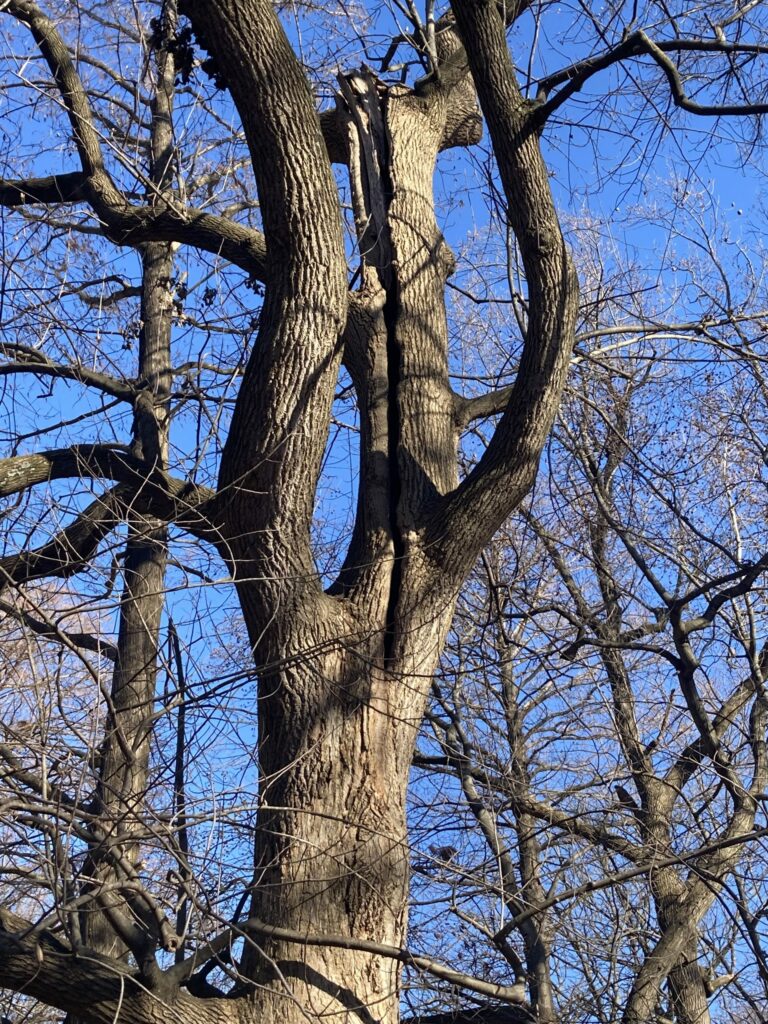By: Mark Halpin, Forestry Manager
Trees, so often being the high points in landscapes, naturally attract a fair number of lightning strikes. The resulting damage is wildly unpredictable; trees can literally explode as if they’ve been stuffed with Looney Tunes-grade TNT, leaving a split and smoldering trunk, or remain essentially unscathed. If a tree is thick-barked and absolutely drenched (quite possible during electrical storms), the outer layer of water conducts the electricity safely to the ground, with little penetration into the living tissue. More often, it seems the electrical current enters the tree and follows the vascular tissue all the way down to the root system, while largely avoiding the inactive (and therefore relatively dry) heartwood. As it passes through these vascular tubes, the water they are filled with is vaporized by the heat and the tissue bursts. The result is a split, sometimes running all the way down the trunk, often accompanied by chunks of outer bark being flung spectacularly into the distance. How damaging this is to the tree depends on a number of factors – the amount of moisture in the tree to be vaporized, the amount on its outer bark to deflect some of the current, the power of the bolt, and of course the tree itself – it’s species type, age, and genetics.
It can be hard to say with complete certainty if a particular tree’s wounds are the result of lightning, but the tulip tree (Liriodendron tulipifera) depicted here is almost certainly an example of this phenomenon. The large open wound at the top likely represents what was the central leader of the tree, which was lost entirely. Being higher up, it was exposed to the full brunt of the strike, and also exposed to wind, which would make it both drier on the outside and already under mechanical stress. From this entry wound, a long crack in the cambium runs almost to the ground. The only other potential cause of such a wound would be a branch failure that ripped a strip of bark off as it fell – also a common occurrence, but tracing this wound’s course shows it to be a highly unlikely explanation for all but the topmost portion.
 Notice how the wound passes through a fork in the tree and wraps around to the side. A failed branch would likely be caught in the fork, or have landed top-down on the ground and ceased its ripping action; bark tears with such a long and winding course are vanishingly rare.
Notice how the wound passes through a fork in the tree and wraps around to the side. A failed branch would likely be caught in the fork, or have landed top-down on the ground and ceased its ripping action; bark tears with such a long and winding course are vanishingly rare.
Assessing past damage is always a fun exercise in deductive reasoning, and in many cases it can be done with a high degree of certainty. But nevertheless, it all amounts to educated guesswork. Hopefully no one was actually around to witness the lightning strike (humans standing close to struck trees are in great danger, not only from falling debris but also from the huge current passing through the ground). What we can say with confidence is that this tree, having conducted ~300 millions volts of electricity through its delicate vascular system into the ground, is handling its malady with impressive grace. In the pictures below, note the open crack, with scars visible above and below. This wound was once open its entire length, and has since almost completely sealed. The thick, rounded “lips” of wood on either side of the open portion are vigorous “woundwood” and an indication that the tree is compartmentalizing its injury effectively.

 Note the scar lines above and below the wound visible on the photo on the left. Within 5 years the entire wound will likely be shut, and within 10 all evidence might be subsumed into the tree’s inner wood, if vigor remains high.
Note the scar lines above and below the wound visible on the photo on the left. Within 5 years the entire wound will likely be shut, and within 10 all evidence might be subsumed into the tree’s inner wood, if vigor remains high.
Less apparent from this picture is that the dead wood inside the wound does not appear to be decayed or damaged. The prognosis is good. As the wound seals, this inactive but sound heartwood will continue to act as structural reinforcement. The woundwood that is slowly surrounding it is in some cases actually stronger than normal growth, being thicker and denser. It is harder to assess the upper portion of the wound, but it too appears to be sealing over quite well. (Even if the tree were to become hollow, this is not necessarily a serious insult to its structural integrity. Think of a stone tower or a steel pipe, hollow but string extremely strong.)
Tulip tree is a very fast-growing species, and this is an otherwise quite healthy specimen that is nowhere near full maturity. 20 years from now, it may still be thriving and only a very discerning and curious arborist would see any evidence of this traumatic event. When it finally does fail, unless it is dissected by another curious arborist, or perhaps sawed into planks (this seldom happens to park trees), the wound will be forgotten entirely. Consumed along with the rest of the tree by decay fungi, and returned to the earth. Think of this as you walk among our old veteran trees, and all of the secrets written in their grain. Keep it in mind when considering tree removal; wounds often look much worse than they really are. As always, consult with an ISA Certified Arborist before deciding to remove a tree




